 Some might remember 2014’s Bye Bye Four One Two Five blog post in which I bid farewell to a long held telephone number and a couple of Cincinnati Bell services. For roughly six years preceding that post, I had relied on CB for my mobile telephone as well as my home phone and internet connection. That had to change because the company was bailing out of the mobile business. When I made that post in October of 2014, I had switched to Verizon for my mobile service and had simply dropped the seldom used home voice service. The only service I retained with CB was an internet connection. In the last paragraph of the post I expressed happy surprise that the internet connection was the same price alone as it had been bundled. That didn’t last.
Some might remember 2014’s Bye Bye Four One Two Five blog post in which I bid farewell to a long held telephone number and a couple of Cincinnati Bell services. For roughly six years preceding that post, I had relied on CB for my mobile telephone as well as my home phone and internet connection. That had to change because the company was bailing out of the mobile business. When I made that post in October of 2014, I had switched to Verizon for my mobile service and had simply dropped the seldom used home voice service. The only service I retained with CB was an internet connection. In the last paragraph of the post I expressed happy surprise that the internet connection was the same price alone as it had been bundled. That didn’t last.
For the first year, my internet-only bill was $35 per month. It then went to a perfectly acceptable $36. Five months later it jumped to $48.54 which was neither acceptable or ignorable. There were, I soon learned, two components to this roughly 35% increase. One was a significant but not quite outrageous jump in the service rate from $36 to $39.99. The larger piece of the increase came from the addition of a $7.99 equipment fee and accompanying $0.56 state tax. Through on-line chat and a subsequent phone call I was able to verify that this was, as I immediately suspected, a monthly rental fee for the nondescript ADSL modem I had been using free since 2008. I was also told that I could neither buy the modem outright from Cincinnati Bell nor supply my own. As the representative looked over my account, she uttered the phrase “wireless internet” and I told her I did not have CB supplied WiFi which she shrugged off and so did I. I guess I had already decided to run away fast rather than pursuing specific issues.
Cincinnati Bell’s current flagship product uses fiber-optics. Called Fioptics, it is not yet available at my address although I doubt its availability would have materially changed things. My service was a copper wire product called ZoomTown 5 Mbps. The service is often described as “5/1” to indicate 5 Mbps download and 1 Mbps upload. These are marketing friendly “rounded up” numbers more precisely described as “Download up to 5 Mbps. Upload up to 768 Kbps”. There is also a ZoomTown 2 Mbps or “2/1” product. Although I have seen download speed as high as 4.47 Mbps, recently observed download speeds have all been under 1.33 Mbps. Observed upload speeds have always been around 0.66 Mbps which is close enough to 768 Kbps to keep me happy. It happens that the only record I have of speeds near 5 Mbps (the 4.47 reading) is from before switching off voice service but I have no evidence that the slowing coincided with the switch.
My most charitable interpretation of this is that Cincinnati Bell made a couple of small errors. It seems quite possible that somewhere along the way I was accidentally switched from the 5 Mbps service to the 2 Mbps service. It is also quite possible that I was somehow supposed to have a WiFi router from Cincinnati Bell but that someone forgot to actually provide it. If that were the case, then I could press Cincinnati Bell and get a fancier modem/router for my $7.99. If an accidental service reduction had actually occurred, then I could press Cincinnati Bell and get it switched back or I could arrange for my billing to be changed to match the service I was apparently receiving.
I might have merely grumbled and moved to get the errors corrected had there not been at least a little bit of competition left in the local internet market. There is, so instead of expending energy trying to get Cincinnati Bell to correct its errors, I switched to Time Warner Cable. Three things led to the switch. For one thing, TWC allows customers to supply their own modems and provides a list of compatible products. Secondly it’s cheaper. I’m starting with a 2 Mbps plan which should be the equivalent of what I’ve actually been getting from CB. The CB rate is $26 per month (although I’ve actually been paying more) and the TWC rate is $14.99 per month. Yes, I had to spend some money up front but I’m getting nearly twenty bucks ($8.55 + $26 – $14.99 = $19.56) back every month. If I should decide I want more, TWC lists 6 Mbps and 15 Mbps plans that are both cheaper than CB’s 5 Mbps plan. The third reason to switch is that TWC hadn’t pissed me off in years.
Getting the new service should have been quick and easy. It wasn’t although neither was it exactly horrible. When the condominium I live in was built in 1997, all units were pre-wired for Time Warner Cable. I subscribed to TWC for a couple of years before going to DirecTV in 1999. The DirecTV installation made use of the TWC cabling and was working fine when I canceled my subscription in favor of over-the-air TV in 2009. An appointment was made and a technician arrived right on schedule. However, after doing a LOT of testing, he told me that there seemed to be a break in the internal cabling and that someone else would need to come out to fix it. I would be contacted within a week.
I let two weeks pass then called. Someone had entered a placeholder appointment for a couple months in the future then dropped the ball. A more qualified tech arrived less than two days later. He looked things over and, rather than pulling new cable as I expected, simply completed the one connection the previous tech had missed. Bingo!
While both services were connected I checked their speeds using Ethernet (not WiFi) and found the Time Warner connection delivering essentially what was advertised:
Cincinnati Bell, not so much:
I know those rates seem pretty pitiful to many. They are the minimum offerings from the two companies but they are sufficient. One might think that, as a feeder of a blog and website, I am a heavy Internet user. Nope, heavy Internet users are families streaming movies to multiple TVs while playing World of Warcraft with friends in Walla Walla, Washington. I certainly wouldn’t object to more speed but I have what I need for less than a Skinny Vanilla Latte Grande per week.
The opening photo shows a detail of the 1931 Cincinnati Bell Building in downtown Cincinnati.

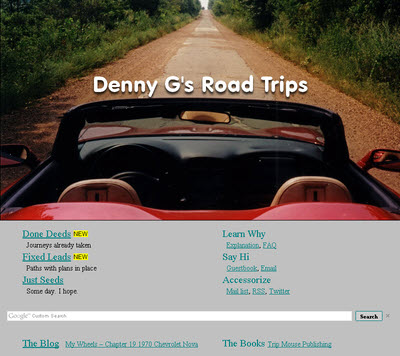 For something that did not even register on my radar a month ago, the concept of mobile-friendly websites has grabbed a lot of space on this blog in the young 2016. The first post of the new year led to me realizing that mobile devices should not simply be ignored. The second post discussed a little of what I had learned and described the first steps taken to be mobile-friendly. And this, the fourth post of the new year, is a report on reaching a milestone on the road to mobile friendliness.
For something that did not even register on my radar a month ago, the concept of mobile-friendly websites has grabbed a lot of space on this blog in the young 2016. The first post of the new year led to me realizing that mobile devices should not simply be ignored. The second post discussed a little of what I had learned and described the first steps taken to be mobile-friendly. And this, the fourth post of the new year, is a report on reaching a milestone on the road to mobile friendliness. The milestone I speak of is having a home page that passes both Google and Bing mobile friendliness tests. That’s it at the top of the article in desktop (actually laptop) view and at the left in smartphone view. It is the biggest change to the website’s front door in at least fifteen years. It retains most of the flavor and function of the previous version but is simpler and scales down a lot better. About the only things missing are the RSS feeds from Route 66 News, Roadside America, and American Road Magazine and the randomly selected road trip photo and link at the page’s upper right. Both came with a lot of overhead and I don’t recall anyone ever complimenting me on either. I personally really liked the random picture thing, however, and have kept it alive with a “Done Deeds”-“All Trips”-“Random” menu item. The Google ads also seem to be fairly high in overhead and, although I’m hanging on to them for the present, I will be keeping an eye on them and they could go missing.
The milestone I speak of is having a home page that passes both Google and Bing mobile friendliness tests. That’s it at the top of the article in desktop (actually laptop) view and at the left in smartphone view. It is the biggest change to the website’s front door in at least fifteen years. It retains most of the flavor and function of the previous version but is simpler and scales down a lot better. About the only things missing are the RSS feeds from Route 66 News, Roadside America, and American Road Magazine and the randomly selected road trip photo and link at the page’s upper right. Both came with a lot of overhead and I don’t recall anyone ever complimenting me on either. I personally really liked the random picture thing, however, and have kept it alive with a “Done Deeds”-“All Trips”-“Random” menu item. The Google ads also seem to be fairly high in overhead and, although I’m hanging on to them for the present, I will be keeping an eye on them and they could go missing.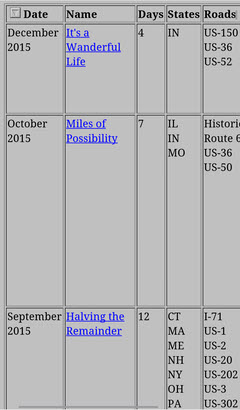 There are a few pages that may never be truly mobile-friendly as Google and Bing see things. Among these are both Oddment and Road Trip index pages. While changes have been made to make text on the pages readable on mobile devices, the table displays overflow smartphone screens in all directions and require zooming and/or panning to view. There are schemes, using pop-ups and such, to make tables slimmer and more mobile-friendly. I don’t really like any I’ve seen and am firmly of the belief that the conversion effort would not be justified for either of these tables. While they might not be officially mobile-friendly, and I have no quibbles with either Google’s or Bing’s criteria, they seem quite usable on my smartphone and I don’t consider them overly unfriendly.
There are a few pages that may never be truly mobile-friendly as Google and Bing see things. Among these are both Oddment and Road Trip index pages. While changes have been made to make text on the pages readable on mobile devices, the table displays overflow smartphone screens in all directions and require zooming and/or panning to view. There are schemes, using pop-ups and such, to make tables slimmer and more mobile-friendly. I don’t really like any I’ve seen and am firmly of the belief that the conversion effort would not be justified for either of these tables. While they might not be officially mobile-friendly, and I have no quibbles with either Google’s or Bing’s criteria, they seem quite usable on my smartphone and I don’t consider them overly unfriendly.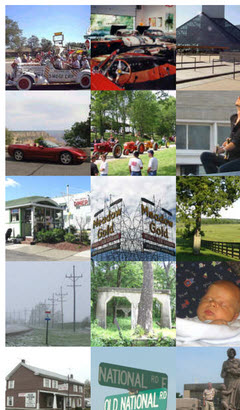 The Clickable Collage is another page which is not officially mobile-friendly. Containing a single photo from every completed road trip, it allows the individual photos to be clicked to access the journal for the associated trip. It was formerly available through a link below the randomly selected photo at the home page’s upper right. It is now reached through the “Done Deeds”-“All Trips”-“Collage” menu item. Although I don’t expect everyone to experience the same memory stimulation I do when viewing the collage, I have to believe that it is most impactful when seen in its entirety. Of course this is best done on a full size (whatever that is) screen where the total view is also actually usable. Making this collage fit a small screen by forcing it into one or two very tall columns just seems wrong and more irritating than impressive. It is clearly not a natural fit for smartphone screens but it can, like those index pages, be viewed and used by panning. It can also be zoomed to fit but, while this view of
The Clickable Collage is another page which is not officially mobile-friendly. Containing a single photo from every completed road trip, it allows the individual photos to be clicked to access the journal for the associated trip. It was formerly available through a link below the randomly selected photo at the home page’s upper right. It is now reached through the “Done Deeds”-“All Trips”-“Collage” menu item. Although I don’t expect everyone to experience the same memory stimulation I do when viewing the collage, I have to believe that it is most impactful when seen in its entirety. Of course this is best done on a full size (whatever that is) screen where the total view is also actually usable. Making this collage fit a small screen by forcing it into one or two very tall columns just seems wrong and more irritating than impressive. It is clearly not a natural fit for smartphone screens but it can, like those index pages, be viewed and used by panning. It can also be zoomed to fit but, while this view of 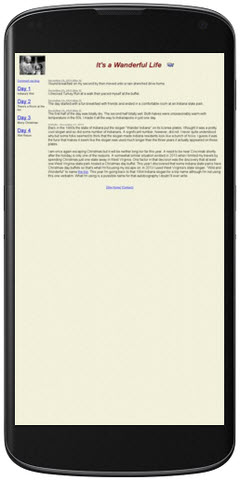 I didn’t do it on purpose, Jim. Honest I didn’t. But, as has happened a time or two in the past, mentioning a problem in a blog post was enough to get some insight from blogger
I didn’t do it on purpose, Jim. Honest I didn’t. But, as has happened a time or two in the past, mentioning a problem in a blog post was enough to get some insight from blogger 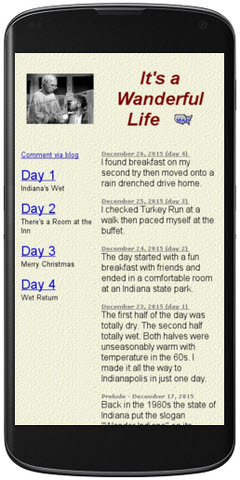 I revisited the Google testing tools and paid a lot more attention to the suggestions. There was some good news. The vast majority of my website is very simple so that adding just one line (to set a mobile viewport) to a page allows it to pass Google’s mobile-friendly test and makes it look better. The page shown at the top of the article reappears at the left with that one line added.
I revisited the Google testing tools and paid a lot more attention to the suggestions. There was some good news. The vast majority of my website is very simple so that adding just one line (to set a mobile viewport) to a page allows it to pass Google’s mobile-friendly test and makes it look better. The page shown at the top of the article reappears at the left with that one line added.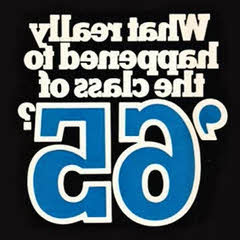 I made a couple more trips this year than last but they were shorter and resulted in less total days on the road. That naturally caused a slight drop in pictures posted to the journal but pictures in the blog increased so that there was not a significant change in the total number of new pictures. In addition to the 52 regular weekly blog posts, there were 14 reviews, 9 road trip links, and 2 miscellaneous asynchronous posts which adds up to just three less blog posts than last year. Three of the new blog posts generated enough traffic to make the top five. The most popular new blog post concerned a little ol’ high school reunion. Once again there were no new posts in the non-blog top five.
I made a couple more trips this year than last but they were shorter and resulted in less total days on the road. That naturally caused a slight drop in pictures posted to the journal but pictures in the blog increased so that there was not a significant change in the total number of new pictures. In addition to the 52 regular weekly blog posts, there were 14 reviews, 9 road trip links, and 2 miscellaneous asynchronous posts which adds up to just three less blog posts than last year. Three of the new blog posts generated enough traffic to make the top five. The most popular new blog post concerned a little ol’ high school reunion. Once again there were no new posts in the non-blog top five. So what’s that mean? One possibility is that a change in the way statistics are compiled or visits detected resulted in an artificial drop in the numbers and I can produce some arguments both for and against that theory. The “for” ones are the weakest. What seems more likely and less palatable is that the numbers don’t lie and readership has truly plummeted. Jim Grey, a friend and popular blogger, recently posted an article he called
So what’s that mean? One possibility is that a change in the way statistics are compiled or visits detected resulted in an artificial drop in the numbers and I can produce some arguments both for and against that theory. The “for” ones are the weakest. What seems more likely and less palatable is that the numbers don’t lie and readership has truly plummeted. Jim Grey, a friend and popular blogger, recently posted an article he called 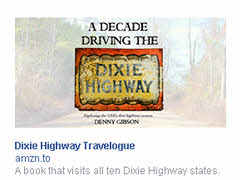 On Friday morning a friend observed on Facebook that he was getting email from every website he had ever visited that had something to sell. His situation was hardly unique. I’m rather confident that everyone with any sort of internet connection was seeing an uptick in activity on the official beginning of open season on customers. The barrage had been building as anxious hunters fired off emails and other communications telling us that their Black Friday started on Thursday or Wednesday or even earlier. This is, I assume, the same sort of time warp that allows certain drinking establishments to advertise “The world’s longest Happy Hour”. I considered emailing him some sympathy but didn’t for two reasons. One was that to do so would be to add to the tide of useless messages in his inbox. The other was that I would soon be part of the problem.
On Friday morning a friend observed on Facebook that he was getting email from every website he had ever visited that had something to sell. His situation was hardly unique. I’m rather confident that everyone with any sort of internet connection was seeing an uptick in activity on the official beginning of open season on customers. The barrage had been building as anxious hunters fired off emails and other communications telling us that their Black Friday started on Thursday or Wednesday or even earlier. This is, I assume, the same sort of time warp that allows certain drinking establishments to advertise “The world’s longest Happy Hour”. I considered emailing him some sympathy but didn’t for two reasons. One was that to do so would be to add to the tide of useless messages in his inbox. The other was that I would soon be part of the problem.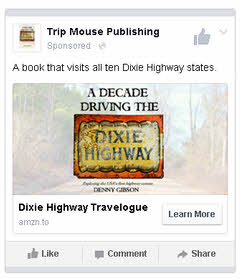 The image at the top of this article shows the ad that appears in what Facebook calls the “Desktop Right Column”. The one at left is for the “Mobile News Feed”. Other variations appear in other channels. As can be seen in the “News Feed” version, the ads are sponsored not by me but by
The image at the top of this article shows the ad that appears in what Facebook calls the “Desktop Right Column”. The one at left is for the “Mobile News Feed”. Other variations appear in other channels. As can be seen in the “News Feed” version, the ads are sponsored not by me but by  We fought a war to get this country going then gave every land owning white male above the age of twenty-one the right to vote. A little more than four score years later, we fought a war with ourselves that cleared the way for non-whites to vote. Several decades of loud, disruptive, and sometimes dangerous behavior brought the granting of that same right to non-males a half-century later and another half century saw the voting age lowered to eighteen after a decade or so of protests and demonstrations.
We fought a war to get this country going then gave every land owning white male above the age of twenty-one the right to vote. A little more than four score years later, we fought a war with ourselves that cleared the way for non-whites to vote. Several decades of loud, disruptive, and sometimes dangerous behavior brought the granting of that same right to non-males a half-century later and another half century saw the voting age lowered to eighteen after a decade or so of protests and demonstrations. Of course, putting something in a constitution does not automatically make it a practice throughout the land and I am painfully aware that resistance followed each of those changes and that efforts to make voting extremely difficult for “the other side” are ongoing today. I don’t want to ignore partisan obstructions and system flaws but neither do I want to get hung up on them. I meant my first paragraph to be a reminder that a hell of a lot of effort, property, and lives have gone into providing an opportunity to vote to a hell of a lot of people. Far too many of those opportunities go unused.
Of course, putting something in a constitution does not automatically make it a practice throughout the land and I am painfully aware that resistance followed each of those changes and that efforts to make voting extremely difficult for “the other side” are ongoing today. I don’t want to ignore partisan obstructions and system flaws but neither do I want to get hung up on them. I meant my first paragraph to be a reminder that a hell of a lot of effort, property, and lives have gone into providing an opportunity to vote to a hell of a lot of people. Far too many of those opportunities go unused. In the title I claim to not care how anyone votes. That’s not entirely true, of course. I have my favorite candidates and issues. I’ll be disappointed in anyone who votes differently than I do but not nearly as disappointed as I’ll be in anyone who doesn’t vote at all. I’m reminded of parents working on getting their kids to clean their plates with lines like, “There are hungry children in China who would love to have your green beans.” I’m not sure what the demand for leftover beans is in Beijing these days but I’m pretty sure some folks there would like to have our access to ballots and voting booths.
In the title I claim to not care how anyone votes. That’s not entirely true, of course. I have my favorite candidates and issues. I’ll be disappointed in anyone who votes differently than I do but not nearly as disappointed as I’ll be in anyone who doesn’t vote at all. I’m reminded of parents working on getting their kids to clean their plates with lines like, “There are hungry children in China who would love to have your green beans.” I’m not sure what the demand for leftover beans is in Beijing these days but I’m pretty sure some folks there would like to have our access to ballots and voting booths.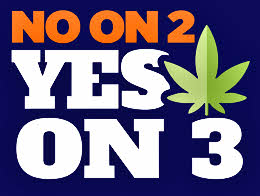 3 is the number assigned to the ballot issue on the legalization of marijuana in Ohio.
3 is the number assigned to the ballot issue on the legalization of marijuana in Ohio.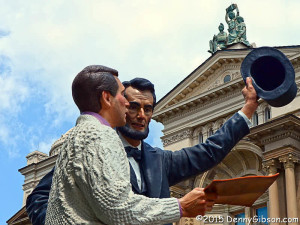 FALSE – I am very much a disciple of Snopes.com but it never occurred to me to check this particular quote there. I should have. When someone referenced the quote on Facebook, the following was included as “also shared”. Thanks, Facebook.
FALSE – I am very much a disciple of Snopes.com but it never occurred to me to check this particular quote there. I should have. When someone referenced the quote on Facebook, the following was included as “also shared”. Thanks, Facebook. 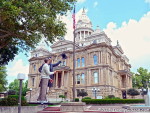
 Nobody sees the trouble I’ve known. Maybe not nobody, exactly, but not many. There are two primary RSS feeds published by this site. One is for this blog. The other is for the trip journal. Among the many ways of subscribing to these feeds is a service called
Nobody sees the trouble I’ve known. Maybe not nobody, exactly, but not many. There are two primary RSS feeds published by this site. One is for this blog. The other is for the trip journal. Among the many ways of subscribing to these feeds is a service called 


